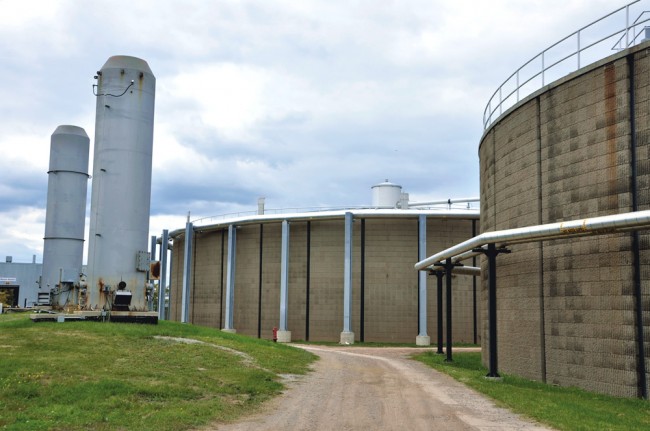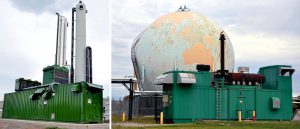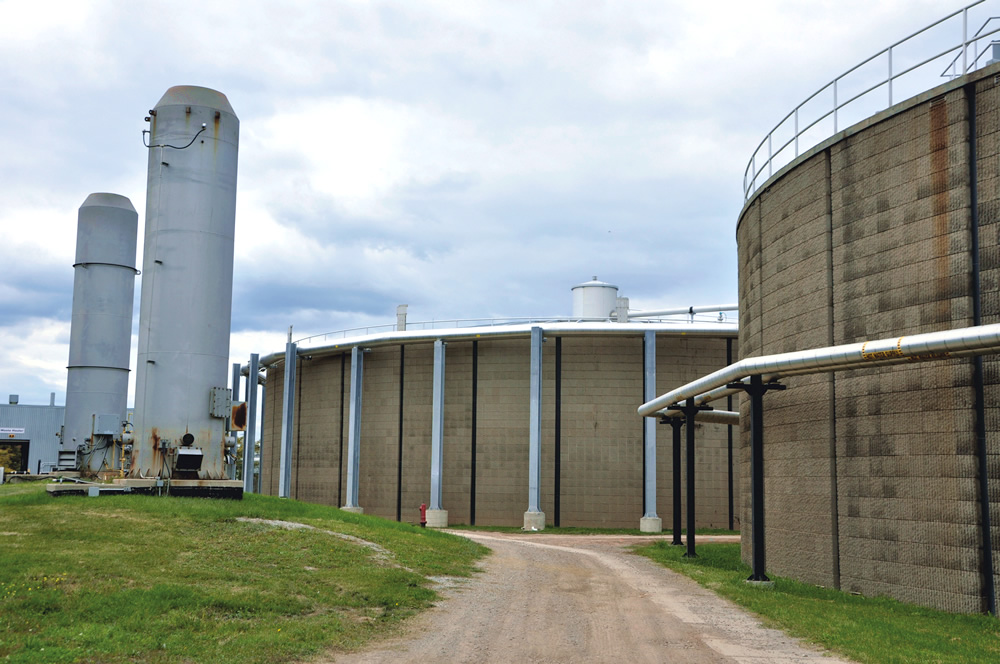The City of Hamilton is purifying biogas and injecting it into the grid, while continuing to generate power and recover heat from its CHP system.
Peter Gorrie
BioCycle November 2012, Vol. 53, No. 11, p. 43

The City of Hamilton is upgrading its treatment plant to process higher flows and add tertiary treatment. Changes will result in more biogas generation in the digesters.
In the past, when the digesters produced more biogas than the 1.6-megawatt CHP engine could handle, the excess was still flared. The new system purifies it into 98 percent methane — a product known as biomethane or renewable natural gas, and identical in performance to the conventional fossil fuel — and injects it into the local pipeline system operated by Union Gas Limited, a subsidiary of Spectra Energy of Houston, Texas. The purification facility began operation in October 2011 and, after a successful commissioning period, has been “fully functioning” since September, says Plamen Nikolov, the treatment plant’s senior project manager.
Advocates say producing biomethane from digesters that feed on wastewater sludge, or on wastes from agriculture, food processing, residential organics collections and the forest industry, is among the most efficient ways to make renewable energy. A study by Alberta Innovates, a corporation created by that province’s government, says this source could replace up to six percent of Ontario’s conventional natural gas supply. The study also estimates that biomethane production from all sources could cut Ontario’s greenhouse gas emissions by up to 13 million metric tons over the next eight years, or nearly half its target of a 15 percent reduction in emissions from 1990 levels by 2020.
Striving To Be Zero-Net-Energy User
While commonplace for decades in parts of Europe, where it’s supported by subsidies in Germany, France and Sweden, biomethane production is just gaining a toehold in the United States, and Canada lags even further. The country’s first biomethane facility is at an agricultural digester in Abbotsford, British Columbia. Hamilton’s $4 million project is, so far, the only one in Canada based on digested solids from a municipal wastewater treatment plant. “By diversifying the end use of our biogas through the addition of biomethane to our existing CHP, we are able to come one step closer to achieving our target of being a ‘zero-net-energy user’ from our Woodward Avenue operations,” says Dan McKinnon, the city’s director of water and wastewater.
The CHP facility usually operates at maximum capacity, which consumes 15,300 cubic meters (m3)/day of biogas. That accounts for most of the current daily biogas production of 17,150 m3. The CHP facility and the biomethane purification plant are owned by the city and operated and maintained by a civic corporation known as Hamilton Renewable Power Inc.
With the city growing, a formal master planning process identified the need to increase the treatment plant’s daily capacity from 108 million to 132 million gallons/day, with upgrades to improve the quality of effluent to meet stricter environmental standards. In total, the plan calls for close to $700 million to be invested over the next 10 years. The major improvement, the addition of tertiary treatment, will generate additional sludge. As a result, more digesters and dewatering centrifuges are planned to handle this growing flow of feedstock.
These changes are expected to raise biogas production by 215 percent, to a daily average of about 37,000 m3, within 20 years. “Innovative thinking allowed us to leverage the original investment plan into maximizing biogas production,” says Dan Chauvin, Hamilton’s director of water and wastewater engineering. “We simply shifted our way of thinking. We’d thicken the biosolids to a higher concentration prior to digestion as opposed to dewatering after digestion. Funds slated for dewatering were then reallocated toward predigestion thickening and minor digester upgrades to increase efficiencies and temperature control. Doing so let us achieve the same overall objectives, while increasing the solids retention time in our digesters, which is what generates the additional biogas.”
However, increasing the volume of biogas only through expansion of the treatment plant wouldn’t be enough for the city to become a zero-net-energy user, McKinnon notes. So plans are in place to investigate codigestion of fats, oils and greases from the restaurant industry as a supplemental fuel source for the digesters. Options to utilize the increased amount of biogas included expanding the CHP plant. But according to a recent report by Hamilton officials and consultants CH2M Hill, that technology converts less than 40 percent of the biogas energy into electricity, compared with biomethane’s 80 percent efficiency. That seemed to make biomethane a better deal, even taking into account the heat recovered from the CHP.

A water-scrubber system for biogas purification — designed to yield 98 percent methane — was supplied by Greenlane Biogas (right). Hamilton has a 1.6 MW CAT combined heat and power unit (far right).
Utility Negotiations
Hamilton’s original plan called for the purified gas to be stored and dispensed at the Woodward Avenue site as a fuel for the water and wastewater fleet to offset the cost of diesel. But, “the idea evolved,” McKinnon says. Officials concluded it would make more sense to put the fuel into the general gas distribution network where it would displace a small part of the conventional supply. From there, the city entered into a “wheeling” agreement with Union Gas.
Through this arrangement, Union Gas doesn’t pay for the biomethane. Instead, it charges the city a small fee to transport the gas on its behalf. The city then buys the remainder of its required supply by conventional means, less the amount of biomethane it has put into the pipeline. In addition to the agreement, the city also paid for the purification and injection facility, built to meet Union Gas’ gas quality specifications, and covers its annual operating and maintenance cost.
After Union Gas came on board, it and Enbridge Inc., another gas distributor, applied to the Ontario Energy Board, the provincial regulator, for permission to set up a payment system for biomethane similar to Ontario’s feed-in tariff (FIT). The FIT program pays varying premium rates for electricity supplied to the grid from wind, solar, water, biogas and other renewable sources.
For biomethane sourced from anaerobic digesters, the two utilities proposed 20-year contracts that would guarantee producers $17/gigajoule for the first 50,000 gigajoules each year — nearly six times the current $3 price for conventional natural gas. They would pay $11/gigajoule for quantities above that limit. The extra cost would be spread among the utilities’ system supply gas customers and, since the biomethane content would be capped at two percent of the total system supply, the increase would be barely noticeable on monthly bills. About two-thirds of the respondents in a survey of 1,500 of the utilities’ residential and commercial customers said they “strongly” or “somewhat” supported the purchase of biomethane if it wouldn’t increase their bills by more than two percent.
Unless biomethane prices were set as proposed, “a viable … industry will not develop in Ontario in the near term,” Union Gas and Enbridge stated in their submission to the Energy Board. While market-based pricing operates effectively in the conventional North American natural gas business, “it does not provide a sufficient level of income or planning certainty for the revenue stream to be realized … in an emerging (biomethane) industry.” Under their proposal, the utilities said, “prices paid by the utilities will allow the emerging market to establish itself until it matures through technology development, producer sophistication, increasing natural gas prices and the potential development of a carbon price. Following this maturation process (biomethane) should be able to compete with conventional natural gas supplies.”
But the Board declined to approve the application, stating that the ”applications cannot be approved on the basis of the current evidentiary record.” The utilities withdrew their application, “without prejudice,” says Drew Everett, market opportunity development project manager at Union Gas. “We could address it again with the Board, in the future.”
Biogas To Biomethane Production
Up to the stage where the biogas is sent for purification, the Hamilton operation is similar to any other large-scale wastewater treatment plant, although it is approaching state of the art with the modifications, described above, to increase the digesters’ production. Eight digesters, each 100 feet in diameter, are located on the Woodward Avenue site. The four oldest are mothballed. Three of the others are in use as primary digesters and the fourth serves as a secondary digester. As the plant’s capacity expands, plans call for a fifth digester to be put into regular service. It would cost about $5 million to refurbish one of the older models or double that amount to build from scratch, says Nikolov.
Currently, most of the biogas produced is directed to an 80-foot diameter storage sphere, which then feeds a Caterpillar G3520C reciprocating gas generator set; the electricity it produces displaces about one-fifth of the treatment plant’s total demand. Heat energy recovered from its operation supplies supplementary heating for the digesters.
As biogas production rises, more will flow to the Greenlane “Rimu” purification facility, where moisture, carbon dioxide, carbon monoxide, hydrogen sulfide, siloxanes, particulates and other impurities are removed to produce nearly 98 percent methane. The facility, with daily capacity of 10,000 m3 of biomethane, was sized to handle the forecasted biogas supply until 2020, but the modular design enables expansion. Its price tag included $2.2 million for equipment; $500,000 for engineering; about $1 million for site preparation, installation, and commissioning costs; and $300,000 for the transfer station to the Union Gas grid. Annual operation and maintenance costs total just under $150,000, compared with $337,000 for the CHP facility.
In the purifier, the biogas is compressed in a two-stage process. Then, it goes into the bottom of the scrubber vessel where it rises through chilled water as the water flows downward. The water absorbs the undesirable soluble gases, leaving almost pure methane to emerge from the top of the vessel. The methane is further purified, dried and analyzed before it’s allowed into the Union Gas system.
The commissioning process appears to have gone smoothly. The start-up was “a challenge. … It takes time for people to get used to the equipment,” Nikolov says. “When it’s adjusted, the purifier isn’t hard to run.” The process monitors itself and sends signals of problems to the city and Union Gas. “When we see an issue they’re already correcting it,” says Everett.
Greenlane, which has operated in Europe for years, has “optimized” its process to convert more than 98 percent of the biogas energy into biomethane, says Sean Mezei, North American president of Flotech and Greenlane. The company has also developed a design that can handle biogas generated from a variety of feedstocks. “There’s nothing unusual in the gas from a wastewater treatment plant but it’s a bit different than biogas from an agricultural digester,” with unique trace impurities, so the process must be adjusted.
Market Potential
The CH2M/Hamilton report notes that it’s difficult to compare the economic performance of generating electricity from biogas or upgrading the gas to biomethane. Higher electricity prices favor the CHP while the economics of purification improve as natural gas prices rise. But the calculation is complicated by the fact that the CHP also benefits from higher natural gas prices, since they increase the savings from capturing heat energy for space heating.
As well, the natural gas price has been “on a bit of a downward roller coaster for the past 10 years,” notes Everett. In any case, biomethane can’t yet stand on purely economic terms, he says. “If you’re ignoring the environmental benefits, it can’t happen at current commodity rates.”
Mezei agrees that it’s difficult for biomethane to compete with the current low prices for conventional natural gas, but emphasizes that comparisons should be made to other types of renewable energy. “[Biomethane] is one of the most efficient ways of making renewable energy … so much more cost-efficient than wind, solar or even generating power from biogas,” he says. “When you put bio-methane on this playing field, it’s very favorable.”
There are, however, signs of progress. In British Columbia (BC), biomethane gets a boost over cogeneration — and is exempt from a $150/gigajoule carbon tax — because virtually all the province’s electricity is produced by hydropower and there’s no environmental benefit in replacing that source with biogas.
In addition, British Columbia’s Utilities Commission allows gas distributor FortisBC to offer its customers the option of designating 10 percent of the natural gas they use as biomethane and paying about double the current price of conventional natural gas for it. The utility can then inject the equivalent amount of renewable gas into its system — paying a premium rate to the producers. The Abbotsford, BC digester, which processes cattle manure and other agricultural residuals, also converts biogas to biomethane in a Greenlane purifier. “It is successful,” Mezei says. “Demand is growing.”
Next up, the Vancouver, BC suburb of Surrey says it plans to build Canada’s largest biomethane facility. The initial proposal is to utilize biogas generated by anaerobically digesting source separated organics from the city’s 100,000 residences as well as the industrial, commercial and institutional sector. But it could be expanded to take wastewater sludge, says Rob Costanzo, Surrey’s deputy manager of operations. The biomethane will likely be injected into the FortisBC pipeline grid, he adds.
In Hamilton’s case, city staff and their consultants say they were able to leverage several initiatives, including innovative planning and design as well as government funding to achieve environmental benefits, create revenue, validate new technology, and provide a full-scale demonstration facility for an emerging renewable biogas market in North America. “Without question, this places Hamilton as an industry leader,” McKinnon says.
Peter Gorrie is a Contributing Editor to BioCycle.










